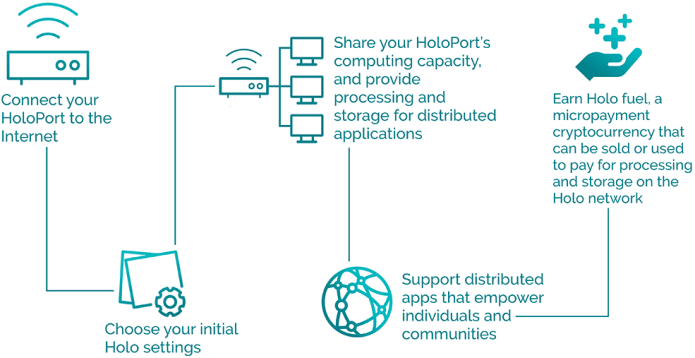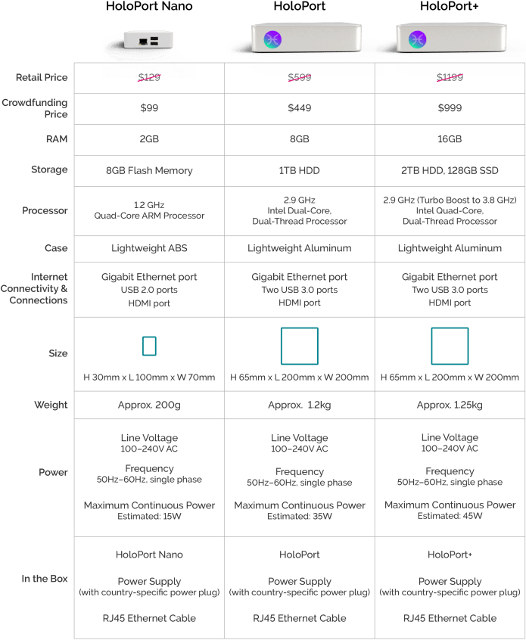The Internet is now mostly centralized, for example most people search with Google, and Facebook dominates the social media space in many countries. That also means access to content can easily be blocked by governments, and many companies will use your personal data to their benefits.
Holo network promises to “take back the Internet” thanks to a P2P distributed web hosting system, where people hosts app from developers in their HoloPort devices, and get paid for hosting crypto apps in Holo Fuel cryptocurrency that can in turn be used to pay for processing power and/or storage on the network, or converted into other cryptocurrencies like Bitcoin, or fiat money (Dollars, Euros…).
 It’s like a new Internet that uses the current “pipes” (i.e. you’d still need Internet through your ISP), but all content would have to be created from the ground up. It basically aims to replace datacenters, websites, and app from larger companies. The first prototype crypto apps include
It’s like a new Internet that uses the current “pipes” (i.e. you’d still need Internet through your ISP), but all content would have to be created from the ground up. It basically aims to replace datacenters, websites, and app from larger companies. The first prototype crypto apps include
- Clutter – a P2P Twitter clone
- Fractal Wiki – a serverless Wiki of cards within cards within cards
- HoloChat – a Slack-like multi-channel chat room for teams
- DPKI – a secure, decentralized cryptographic key management too
App / website developers would pay for Holo network, just like they pay for hosting services currently, and people are incentivized to buy HoloPort hardware as they could eventually get their money back and make some if the system is popular. You’d still use your web browser to access crypto apps (just type an URL) in the Holo P2P network, and other websites in the “centralized Internet”.
Three types of HoloPort – basically Linux computers – are available with HoloPort Nano based on a quad core ARM processor with Gigabit Ethernet, and larger HoloPort & HoloPort+ powered by more powerful Intel processors, and equipped with more memory and storage.

Holo and Holo Fuel are based on Holochain described as “a next-generation platform that is more scalable, exponentially faster, far more energy efficient, and 10,000x cheaper than blockchain”. More details can be found in this document (PDF), and you can checkout the software on Github. The project is still at the alpha stage with the first stable release expected in Q2 2018. The company is now raising funds through and Initial Community Offering (not available in the US), and an Indiegogo campaign where they offer HoloPort hardware as rewards.
The crowdfunding effort started on a roll, as Holo has already received over $220,000 in pledges from around 530 backers. HoloPort Nano requires a $99 pledges, while the Intel platforms cost $449 or $999. Currently the pledges are fairly evenly distributed among the three platforms because the idea is that you’ll be able to serve more users with a faster computer, hence earn more Holo Fuel. Altough the start of the Indiegogo campaign is impressive, the whole project is quite ambitious, so we’ll have to see how it turns out. But in the worst case, with the project failing, you’d still have a Linux computer to play with. [Update: Alternatively, if you don’t want to buy hardware for it, but still want to support the project, you could pledge $40 for the Alpha/Beta Tester rewards to get early access to Holo and Holochain app developer tools].
More details may also be available on holo.host website.

Jean-Luc started CNX Software in 2010 as a part-time endeavor, before quitting his job as a software engineering manager, and starting to write daily news, and reviews full time later in 2011.
Support CNX Software! Donate via cryptocurrencies, become a Patron on Patreon, or purchase goods on Amazon or Aliexpress






Heh… Did you catch that a company is making it…? The more things change…the more they stay the same.
Thank you, but no. There’s a way of accomplishing this goal without one player controlling it. With Holo…you’re at their mercy, to be honest- if it were such that I could roll my own node with whatever I could lay hands on…I’d believe them. Otherwise, they’re just another wannabe Google or Failbook wanting to get their own position there for free at my expense.
Yup. You can do this without any hardware from Holochain. buying the boxes is not mandatory.
what a (holo)joke…
https://net2o.de/ There’s a Forth beta implementation packaged with the Android gforth app in the play store: https://play.google.com/store/apps/details?id=gnu.gforth&hl=en
I doubt it will get much traction until some big name company decides to run it. Still, while early beta, it’s freely available and working…
Full Disclosure: I have volunteered as part of this project for three years and have been employed as a member of Holo for a few months.
1) You do not need to purchase a Holoport to participate in Holo. Any computer can be used. We are simply selling Holoports as a plug-and-play option to make it easy for anyone to participate.
2) Holochain applications are not only open source, they operate independent of any entity, including ours. Holo is not required to run Holochain applications. It is itself a Holochain app that performs a specific service: It makes it easier for P2P Holochain apps (like a version of Airbnb that is controlled by the hosts themselves) to connect with anyone through a web browser. That enables anyone to book a room just by opening a web browser and typing in a URL. Holo helps create a bridge between the P2P apps and the old centralized web. In that sense, it is an attempt to make the transition to a distributed internet a faster one. The hosting work is always done by someone that is a member of the application community itself. Holo just helps with the accounting and payment processing for this particular form of “service.”
3) Holo is incorporated. However, we have given no equity to investors, or even to employees. Why? Because we are planning to hand over control of the organization to the community itself. We are starting at launch with the community able to control a small percentage of how our budget is allocated and will be increasing that control over time. Our goal is to bootstrap a more distributed internet. This is a step in the process – and it is a transitory step. At some point, if we are successful, building bridges back to the centralized web won’t be needed anymore and neither will Holo.
If you are interested in learning more, please check out:
our Green Paper: (CNXsoft edit: Link already in post)
or a recent interview I did with Crypto Ticker. The first fifteen minutes give a good overview of what we are doing and why we are doing it: https://cryptoticker.io/video-holo-announces-holoport-reinvents-internet/
Thanks,
-Matt Schutte
The total list of Holochain apps that currently exist to run on all this hardware can be found in the github link in the post.
I think the issues with this ‘wonder platform can be summed up when you go looking for the SDK, you get taken to an html page stuck on port 3333 of a non-working site.
Overall, yes I would love to sign up for a proprietary, single-vendor platform and also play vast sums for very basic hardware built from bottom of the line parts that will one day hopefully run software that has not even left alpha development.
What is worth reading up on is their claims for their Holochain solution which they claim can replace current Blockchain designs with something that scales and without all the other limitations.
Are you daft? You are spreading gibberish without any basis whatsoever. Holochain is not proprietary. It’s open source. Anyone is free to verify the code. Even the Holo app that requires payment in Holo fuel to the service providers is optional. Developers can choose to use the Holochain directly for free.
The Holoport is also not required to be a part of the network and provide hosting services. It’s just a plug and play solution for the noobs. Competent people will be able to download their software on any linux machine and configure it themselves.
It’s sad that even when some people are making a genuine effort to change the world, pessimistic people like you come in here with your vitriol and hatred and spread wrong information with malintent.
@Roger
If you are calling Holo a proprietary, single-vendor platform, then you obviously didn’t read what Matt said right above you. Nor did you take any time to do more than shoot of your mouth to show how little your brain functions. Reading any of the white papers, or following any of the videos on YouTube and you would see that if you wanted to right now, you could put together your own team of people and start to develop any app you want. Plenty of people are using the SDK, You are too lazy to ask for help with locating it. Or to report an issue, because you would rather assume malintent. Hope your life is going well for you otherwise.